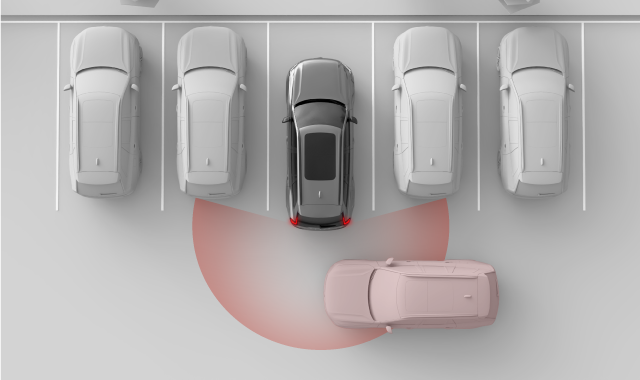Forms of detection
The car has several ways to identify objects that are in or approaching your reversing path. If it detects an object, the car can provide warnings or intervene by braking.
| Parking sensors | These sensors can identify certain obstacles immediately behind the car when reversing at low speeds. |
| Rear-facing radar | The car's rear radars can detect traffic approaching your reversing path from the sides. |
| Camera detection | Certain features may use camera detection to help identify obstacles when reversing. |
Important
When you are reversing, some information from the detection systems can be communicated in the parking view.
Warning and intervention features

| Alerts about traffic crossing behind the car1 | Your car can provide visual and sound alerts if it detects traffic about to cross your reversing path. |
| Automatic braking when reversing2 | The car can automatically brake to prevent a collision when reversing. This can happen if it detects an obstacle or crossing traffic behind the car. |
| Assisted parking sound alerts | Your car can provide visual and sound alerts if it detects objects in, or close by, your reversing path. |
Tip
Temporary deactivation
The assisted parking sound alerts and the rear auto brake can be temporarily turned off if the interventions are too frequent or distracting. For example, reversing in tall grass or manoeuvring in very tight spaces can cause unwanted warnings or braking interventions.
Important
Use responsibly
Warnings and interventions when reversing are supplements to safe driving practices. They do not reduce or replace the need for the driver to stay attentive and focused on driving safely.
Pay attention to surroundings
The driver is always responsible for paying attention to the car's surroundings and ensuring that it is safe to manoeuver the car.
Speed conditions
The rear auto brake is available when you are reversing at speeds below 10 km/h (6 mph), whereas cross traffic alerts are available when you are reversing at speeds below 15 km/h (9 mph).
Detection conditions
Detection of traffic or obstacles behind the car relies on detection by the rear radars and the parking sensors. Be sure to read the separate section about limitations of radar detection.
If the car deactivates the rear radars or the parking sensors, the cross traffic alert and rear auto brake features are automatically disabled. This happens if a trailer is connected. Towbar-mounted accessories that are not connected electrically to the car does not disable the rear radars, but can obstruct them.